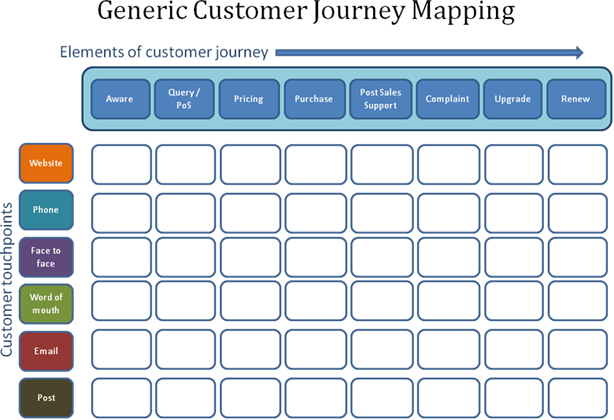Customer Journey Mapping (CJM)
Introduction
One of the biggest challenges facing companies when they want to become customer focused is that their own organisation is based around functional silos. This is not only noticeable to customers as they are passed from function to function looking for service, but also to companies themselves either when they look to start a customer improvement initiative, or look to implement change based around customer feedback. With organisational hierarchy based around functions the ability to make effective decisions and push through change is fundamentally opposite to how a customer wants to experience dealing with them. A customer wants to experience an organisation that provides a single seamless journey across all touchpoints from initial enquiry right through to any required post sales support. An approach to overcome these barriers is to consider the total customer journey.
We have all experienced the situation where you are told one thing before purchasing a service / product, whether that is by a sales person, reading through general marketing literature, or reading the company’s website, and then post sale receiving a completely different experience. It is as if you are dealing with at least two different organisations. Every time a customer contacts the organisation or its representatives, there is an opportunity for a customer “moment of truth”. These “moments of truth” are opportunities for the organisation to make a good or bad impression on the customer and are key moments in the customer journey. My recent example was buying a washing machine from a well known white goods manufacturer, which was actually supplied through a website of a high street retailer, and the after sales service being provided by a third branded party. Although I later found out that the after sales company was actually owned by the manufacturer no one would take ownership of the total experience from what I thought I had bought, to the level of service that I did (or didn’t in this particular case) receive from the after sales organisation. They couldn’t understand my frustration! In my experience with the white goods manufacturer, my “moments of truth” were overwhelmingly negative – not conducive to placing my custom with them next time. Perhaps what had happened was the colliding of more than one customer journey.
So what is Customer Journey Mapping (CJM)?
It looks at mapping out the total customer experience across all touchpoints between the customer and the organisation, from initial contact, through purchasing, after sales support, and hopefully onto renewal / repurchase. It maps the experience that:
- you want to provide to the customer
- the customer would like to receive
And what are the most important factors from the customers’ perspective in determining whether they will remain loyal to your brand?
The gaps between the desired customer experience and the one actually received – the “moments of truth” – indicate where the actions need to be focused.
In the outline Customer Journey map below we have listed what could be the key elements in the customer journey starting with Awareness and progressing through Purchasing right through to Renewal.

Each element of the customer journey (e.g. Aware, Query …) will probably have a number of customer touchpoints such as accessing the website, or calling the organisation. Possible touchpoints (or opportunities for customer moments of truth) are illustrated below. What the company needs to do is ensure the customer receives the quality of experience they require at each of these touchpoints, thereby providing positive customer moments of truth.

For each of these customer touchpoints against each element of the customer journey, the organisation then needs to identify:
- An owner
- The impact it has upon the customers’ experience
- The gaps between desired and current performance
This then allows the organisation to focus on issues that are key for both the customer and them. The creation of the journey highlights to different functions across the business where they come into contact with customers and where they influence the customers’ experience and have the opportunity to provide positive customer moments of truth, which may also be at a much later point in the journey. A recent example for me was when buying a settee I was told by the sales person the delivery date. I therefore scheduled decorating and removal of the old settee around that date. A whole month before it was due I was told by the delivery company that it had arrived and I needed to accept delivery within the next week. So an expectation set at the point of sale had a major impact at the point of delivery. Different functions within the same business but all part of the same customer journey.
What are the key benefits of Customer Journey Mapping (CJM)?
A summary of the key benefits of Customer Journey Mapping and drawing up Customer Journey maps would be:
- Provides a single cross business unit view of the experience delivered by all customers facing functions
- Defines key enabling requirements (skills, data, processes, measures, etc.)
- Highlights areas of importance (where effort should be applied) and areas not valued by customers (so costs can be optimised)
So when should Customer Journey Mapping (CJM) be utilised?
You should expect to receive significant benefit through utilising this approach when you want to achieve any of the following:
- Understand the experience of different groups of customers
- Improve efficiency and remove inconsistencies in the customer’s experience
- Identify a more seamless experience across businesses, functional silos and channels
- Design a new customer experience
- Assess the impact of wider internal developments on the customer’s experience
- Establish development priorities
- Develop cross business alignment across the organisation
- Improve your single overall measure of customer expereince
With growing utilisation of this approach there are an increasing number of examples of organisations that are reaping the benefits of either utilising this approach, or one closely related to it. A variety of industries are being covered included airlines, hotel and hospitality, mobile phone companies, public sector organisations, financial services industries etc.
Beyond Customer Journey Mapping
Customer Journey Mapping is an excellent tool, but to be effective it needs to be consistent with a complete customer focus framework if organisations are to maximise the value from it.
What our clients say
We have worked with a number of clients on helping them develop their Customer Journey Maps, whether it be in retailing with AS Watson, or in a B2B environment with Network Rail, find out their views on how we have helped them.
Take the next step
If you would like to find out more about these and how Customer Champions could support you in travelling along the Customer Journey, please get in touch.
Alternatively if you would like some support on developing a brief on Customer Journey Mapping we can help.

